An Ottoman engraved brass stamp in the shape of a hand, for talismanic printing, circa 18th century. The face of the stamp is engraved with Qur'anic verses and prayers in mirror image. The negative image on the right shows the script correctly orientated. 1/ 

A round metal flange by which to hold the stamp and impress it, is soldered to the back. Such stamps were used to print paper and fabric with motifs and Qur'anic verses that would provide the possessor with talismanic or amuletic protection. 2/ 

The script on the stamp includes the names of various prophets: Moses, Jonah, Noah, Jesus, Isaac, Solomon, Elias etc. The prophets are described in terms of their relationship with God, eg ‘Moses the speaker with Godʼ, ‘Jesus, the Soul of Godʼ, ‘Abraham, the ‘khalilʼ of Godʼ. 3/ 

This stamp is about 18 cm long by 14 cm across. A related, but much smaller hand-shaped stamp in brass and dated 1154 AH (1741-42 AD) is in the Nasser D. Khilili Collection and is illustrated in Leonie (2016, p. p. 87) and Maddison & Savage-Smith (1997, p. 140). 4/ 

Here's an example of how stamps like this were used: this talismanic sheet, printed from similar brass engravings, was removed from the walls of the Mosque of St Sophia in the Peloponnese by Capt. William Fordyce Blair, at the taking of the Castle of Morea on 30th Oct 1828. 5/ 

• • •
Missing some Tweet in this thread? You can try to
force a refresh


















